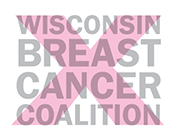On October 20, 2016, WBCC welcomed participants in our 2016 Speaker Forum on “Obesity and Breast Cancer” at Columbia St Mary’s Hospital in Milwaukee.
 Amy Trentham-Dietz (UW-Madison Carbone Cancer Center) started the evening with an overview of “Obesity and Breast Cancer.” She began by defining terms. Generally, researchers use Body Mass Index, a height to weight ratio, to define the terms “overweight” and “obese.” A BMI of 25-29 is considered overweight, and a BMI of 30 or more is considered obese. (Categories change approximately every 5 BMI units.) Since 1970, US obesity rates have seen the highest increases world wide. In 2010, 70% of Americans were overweight/obese, and this is predicted to be 75% by 2020 (even though recent reports show rates of increase leveling off.) Obesity is highest in the US South, with WI rates mirroring the US average (i.e. 33% of WI adults are obese). While for premenopausal women, being obese probably decreases breast cancer risk, this is offset by convincing data that for postmenopausal women, weight gain and more belly fat along with alcohol intake raises breast cancer rates. For each 11 lbs in weight gained after menopause, there is an 11 % increase in breast cancer risk. The big takeaway, Trentham-Dietz said, is “Just move.” Physical activity bestows positive health benefits across the board, including towards breast cancer risk.
Amy Trentham-Dietz (UW-Madison Carbone Cancer Center) started the evening with an overview of “Obesity and Breast Cancer.” She began by defining terms. Generally, researchers use Body Mass Index, a height to weight ratio, to define the terms “overweight” and “obese.” A BMI of 25-29 is considered overweight, and a BMI of 30 or more is considered obese. (Categories change approximately every 5 BMI units.) Since 1970, US obesity rates have seen the highest increases world wide. In 2010, 70% of Americans were overweight/obese, and this is predicted to be 75% by 2020 (even though recent reports show rates of increase leveling off.) Obesity is highest in the US South, with WI rates mirroring the US average (i.e. 33% of WI adults are obese). While for premenopausal women, being obese probably decreases breast cancer risk, this is offset by convincing data that for postmenopausal women, weight gain and more belly fat along with alcohol intake raises breast cancer rates. For each 11 lbs in weight gained after menopause, there is an 11 % increase in breast cancer risk. The big takeaway, Trentham-Dietz said, is “Just move.” Physical activity bestows positive health benefits across the board, including towards breast cancer risk.
 Lisa Arendt, Assistant Professor of Comparative Biosciences at UW-Madison in the School of Veterinary Medicine, spoke about “Obesity and the Normal Breast, Enhancing Long Term Risk.” Her “cage side” work focuses on generating models in mice that can be used to understand breast cancer. Myoepithelium cells function as “squeezers” or a barrier for the cells. Invasive breast cancer can happen as a result of the break down of the myoepithelium layer. Research shows that after 16 weeks, obese mice show a reduction in mammary tissue. BMI also correlates with elevated estrogen expression. The cycle is this: Obesity in youth can result in an early loss of myoepithelium, reducing the barrier against progression of invasive carcinomas. As estrogen increases, triggering an immune response, estrogen is created as part of that immune response. Finally, there is evidence to support the fact that estrogen markers may proliferate on their own.
Lisa Arendt, Assistant Professor of Comparative Biosciences at UW-Madison in the School of Veterinary Medicine, spoke about “Obesity and the Normal Breast, Enhancing Long Term Risk.” Her “cage side” work focuses on generating models in mice that can be used to understand breast cancer. Myoepithelium cells function as “squeezers” or a barrier for the cells. Invasive breast cancer can happen as a result of the break down of the myoepithelium layer. Research shows that after 16 weeks, obese mice show a reduction in mammary tissue. BMI also correlates with elevated estrogen expression. The cycle is this: Obesity in youth can result in an early loss of myoepithelium, reducing the barrier against progression of invasive carcinomas. As estrogen increases, triggering an immune response, estrogen is created as part of that immune response. Finally, there is evidence to support the fact that estrogen markers may proliferate on their own.
 Rulla Tamimi, Associate Professor in the Department of Epidemiology at Harvard, addressed “Body Size Across the Life Course and Breast Cancer Risk.” She explained that beginning in utero, birth size is associated with BC risk. In adolescence, factors affecting risk include radiation exposure, early puberty and early menarche (onset of periods). After puberty, pregnancy’s increased circulation of estrogens leads to higher risk, while lactation lowers risk. At menopause, hormone therapy is associated with higher risk for hormone-receptor positive breast cancers. Perhaps counter-intuitively, Tamimi said findings show that pregnancy weight gain reduced benign breast disease in children. Maternal weight gain during pregnancy is inversely associated with mammographic density in offspring (the heavier the mother, the more fatty and less dense the child’s breast tissue). On the other hand, birth size is a proxy for in utero environment: this means higher birth weight is associated with higher mammographic density. Being heavy early in life (adolescence) is associated with a 50% reduced risk of premenopausal breast cancer compared to girls who were lean. Tamimi’s conclusion: What your body size is early in life has a lifelong affect in which overweight is inversely correlated with breast cancer. She notes we need more studies to understand this mechanism.
Rulla Tamimi, Associate Professor in the Department of Epidemiology at Harvard, addressed “Body Size Across the Life Course and Breast Cancer Risk.” She explained that beginning in utero, birth size is associated with BC risk. In adolescence, factors affecting risk include radiation exposure, early puberty and early menarche (onset of periods). After puberty, pregnancy’s increased circulation of estrogens leads to higher risk, while lactation lowers risk. At menopause, hormone therapy is associated with higher risk for hormone-receptor positive breast cancers. Perhaps counter-intuitively, Tamimi said findings show that pregnancy weight gain reduced benign breast disease in children. Maternal weight gain during pregnancy is inversely associated with mammographic density in offspring (the heavier the mother, the more fatty and less dense the child’s breast tissue). On the other hand, birth size is a proxy for in utero environment: this means higher birth weight is associated with higher mammographic density. Being heavy early in life (adolescence) is associated with a 50% reduced risk of premenopausal breast cancer compared to girls who were lean. Tamimi’s conclusion: What your body size is early in life has a lifelong affect in which overweight is inversely correlated with breast cancer. She notes we need more studies to understand this mechanism.
WBCC thanks all who participated in the informative event, particularly our speakers listed above and our sponsors, the Cedarburg Junior Women’s Club and Columbia St. Mary’s Hospital.
